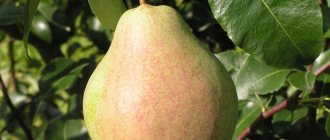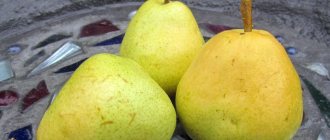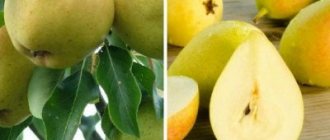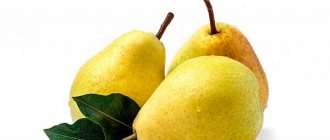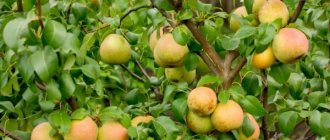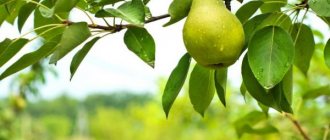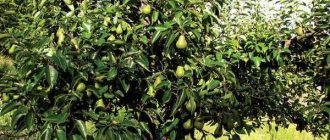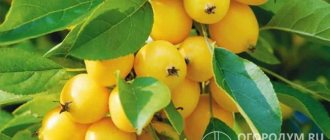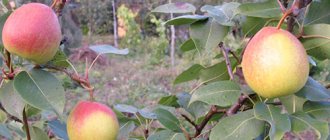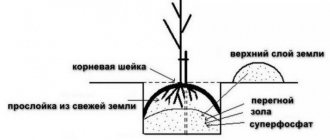History of selection and region of breeding
Elegant Efimova is a new variety that appeared in the thirties of the last century. Its discoverer is breeder V. A. Efimov. This fruit was made thanks to Clapp's Favorite and Tonkovetka. The harvest can be harvested in early autumn. This feature is important for the Central region of Russia, for which this variety was invented. The fruits have taken root well in Moldova, Ukraine, as well as in Kazakhstan and Estonia. They are in no way inferior in taste to everyone’s favorite Festive pears.
Climatic conditions
Pear trees of the Naryadnaya Efimova variety are highly resistant to frost.
Hybrid growing regions
Elegant Efimova is successfully cultivated in the following areas:
- Central region of Russia;
- Moldova;
- Ukraine;
- Estonia;
- Kazakhstan.
When grown in colder climates, the tree needs to be insulated for the winter.
What type of pear is it?
Pear "Naryadnaya Efimova" belongs to the autumn varieties with an early type of fruiting. This variety is used in hybridization as a donor of high yield and frost resistance.
At the end of the 80s, an agricultural exhibition was held in Erfurt (Germany, Thuringia).
This pear variety received special attention and was awarded a gold medal for its excellent qualities and excellent presentation.
The appearance of the pears was rated 4.5 out of 5. Sweet and sour taste 4 points.
Sugar content varies from 9.1 to 9.3%; acid content from 0.10 to 0.13%.
Reviews
Galina
Vasilyevka
Pears of the Naryadnaya Efimova variety are beautiful, and if picked in time, they are juicy and tasty. It doesn’t last long, but it makes fragrant jam.
Konstantin
Samarka
There are several varieties of pears in our garden, including Naryadnaya Efimova, which ripens earlier than others. The tree in our area tolerates winter well.
Vladimir
Zhdanovka
My family, children and grandchildren love pears very much. That’s why we have 3 different varieties of pears in the garden; Naryadnaya Efimova is already bearing fruit. The pears are tasty and juicy. The tree is not affected by scab and is resistant to pests
Description of the pear Elegant Efimova
The height of the tree reaches 4-5.5 m. Its crown is of a pyramidal type. The branches extend from the trunk at sharp angles. They have an average number of leaves, which look like large ovals. The shoots are painted in dark red tones. The bark of the variety is smooth, gray in color. The buds have an elongated shape and a smooth surface.
Fruit characteristics:
- the average fruit weight ranges from 90-120 g, but some gardeners managed to obtain specimens weighing up to 180 g;
- subcutaneous inclusions are visible under the smooth skin;
- fruits are removed from the tree when they are colored green and yellow;
- a fully ripe pear has a burgundy color;
- large seeds;
- the pulp is juicy and tender, white in cross section;
- the taste is sweet, with a small amount of acid.
Note: It is recommended to remove unripe fruit from the tree. In this form, they are stored longer (from 15 days to a month) and can be transported over long distances. If the fruits are left to ripen on the branches, their taste deteriorates and they themselves disintegrate.
This pear hybrid has a yield of up to 40 kg per tree. Fruiting begins 6-8 years after planting the seedlings.
In sunny summers, the harvest is carried out in the last days of August, and in cloudy weather it is postponed until September. The description of the smart Efimova pear in the agricultural catalog states that the variety has good frost resistance. In winter, an adult tree does not need to be wrapped, but young seedlings are recommended to be insulated with special material (reeds) and protected from small rodents.
This pear hybrid develops well in poor soils, which makes it possible to grow it almost everywhere. The main pollinator for this variety is the bee, but it is advisable to place pear hybrids of a different type next to it for cross-fertilization.
Note: the plant is not susceptible to scab, bacterial infection, cancer, or fruit rot. It is resistant to gall mites and other garden parasites.
Tree
The elegant Efimova grows up to five meters in height. The crown density is average. It grows very quickly. The main branches extend from the trunk at an angle of thirty degrees. The bark is smooth and gray. The shoots are straight and brown. The leaves are large, oblong, with jagged edges. The color is green, with a smooth, glossy surface and clearly visible yellowish veins.
The flowers are small, white, fragrant. The flower petals are oval in shape. The lower flowers bloom first, and later the upper ones. Non-simultaneous flowering helps the tree survive sudden spring frosts and produce a good harvest. Some flowers survive after zero temperatures.
Tree dimensions and height
The tree reaches a maximum height of 5 m, its crown is of medium density. The branches grow in relation to the trunk at an angle of 30°. The bark is gray, smooth.
Fruit
Medium-sized fruits can weigh 100, and sometimes 140-175 grams. They have an elongated pear-shaped shape. The skin of the fruit is smooth, with noticeable subcutaneous dots.
The fruits are initially green, but as they ripen they turn yellow and are covered with a purple color on top.
At the moment of full ripeness, the color of the fruit is 95 percent burgundy. The calyx does not fall off; red dots are visible near it on the yellowish-green skin. Inside are large dark brown seeds.
The pulp of the fruit is creamy in color. It is semi-buttery and dense, but at the same time tender and juicy. The taste is sweet and sour, but a little tart.
Taste and use of fruits
The taste of pears of this variety is slightly astringent. In general, the tender and very juicy pulp has a balanced sweet and sour taste. The harvested crop is used for:
- fresh consumption;
- additions to creams;
- preparing cakes and confectionery;
- cooking meat dishes;
- preparations of jam and compotes;
- making marmalade;
- preparing desserts.
How to grow a tree
The plant feels good in spacious areas that are illuminated by sunlight. If you grow it in shaded corners of the garden, the fruits will become smaller and their sweetness will decrease.
Although the elegant Efimova can grow in poor soil, it is better to place it in black soil, loamy or sandy soil. If its acidity exceeds 6 pH, the soil is fertilized with lime and wood ash.
For planting, young trees that are 1-2 years old are purchased. Their height should exceed 60 cm in the presence of formed skeletal branches. The bark on the cuttings should not have rotten areas or chips.
Pear hybrids are planted in autumn or early spring. To do this, dig a hole 0.75-0.8 m deep and up to 1 m in diameter. Manure or humus (up to 30 kg), superphosphate and potassium sulfide (0.1 kg each) are laid inside. A stake is strengthened in the center of the hole, which serves as a support for the seedling. Then they install the tree and cover it with earth. Make a circular ditch around the trunk and pour 3 buckets of warm water into it.
The description of the Naryadnaya Efimova pear states that to increase its yield, the following pollinators must be planted next to it:
- Marble,
- Bessemyanka,
- Yakovlev's favorite.
Plum manicure: fashionable design ideas and beautiful design options. 105 photos of stylish solutions
It is advisable to have 2-3 types of hybrids on the site. Planting care is needed throughout the growing season.
Fruit trees are irrigated every 6-7 days. To do this, early in the morning, 20 to 30 liters of oxen are poured under each young pear. If the weather is hot or drought, the intensity of moisturizing is increased 3 times. If there are fruit-bearing trees in the garden, they are watered 2 times a season (during bud break and at the end of flowering), 50-60 liters of water are poured under each plant.
Fertilizers begin to be given to pear seedlings in the spring. Fertilizing is carried out with ammonium nitrate. The next time the procedure is carried out in the fall, but the trees are already given potassium mixtures at the rate of 20 g of the substance per 10 liters of water. When forming buds, it is advisable to treat the hybrids with superphosphate, and after flowering - with nitrophoska. When ovaries appear, wood ash is introduced into the soil.
This variety needs magnesium. Feeding with microelements is carried out at the beginning of summer. To do this, use a solution of metal sulfate in water (0.2 kg of chemical per bucket of liquid).
Weeding of the tree trunk circle from weeds is carried out once a month. The soil under the pears is mulched with a layer of peat and sawdust. Its thickness must be at least 100 mm.
Pruning of pear hybrids is done in the spring. Remove all old, dried out or diseased branches, shorten young shoots by 1/3.
To prevent diseases, pears are processed as follows:
- sprayed with urea solution in early spring;
- bleach the trunks with lime 2 times a year;
- remove fallen leaves, dry and diseased branches.
Such measures are recommended only if diseased trees are found in the garden.
To prevent diseases, pears are treated
If the hybrids are attacked by garden pests, the parasites are destroyed using drugs that kill both the insects themselves and their eggs and caterpillars. Although the Naryadnaya variety suffers little from them, it is recommended to constantly inspect the plants and take protective measures in time.
An adult tree tolerates winter cold well, so it does not need special protective equipment. After planting, seedlings need to be wrapped in warm materials (2-3 years), and when the air temperature drops sharply, it is advisable to fumigate their trunks with smoke.
Characteristics
The pear variety “Naryadnaya Efimova” produces stable fruit. The productivity of this variety is high. Up to 30 tons of fruits are harvested from one hectare of land.
Harvesting takes place in the first ten days of September. In good sunny weather, the fruits can ripen earlier - in the second decade of August.
Pears of this variety must be picked in a semi-ripe state, when the color of the fruit is emerald with slight shades of amber color. Otherwise, when the fruits become overripe, their taste is lost.
Important! After harvesting, unripe pears should lie in refrigerators for 2-3 days until they are fully ripe and acquire an amber-burgundy hue.
The pulp becomes viscous, watery, crumbly. In cool storage, the storage time for fruits is 14-21 days.
Fruiting begins 7 or 8 years after planting.
This pear variety is a frost-resistant variety.
It does not require covering trees for the winter.
Frost and drought resistance
The Naryadnaya Efimova pear variety is highly frost-resistant and overwinters in the middle zone without additional shelter. The tree can tolerate moisture deficiency, but at the same time the yield drops significantly, and the taste and marketability of the fruits decrease. Also, a white powdery coating appears on young twigs and foliage.
Immunity to diseases and insects
Elegant Efimova has increased immunity to the following diseases:
- bacterial burn;
- scab;
- moniliosis;
- cancer;
- pear rust.
It is important to note that the fruits are not subject to rotting or spotting. Pears are also resistant to the negative effects of pests. Such advantages enable gardeners not only to save money and time on preventive treatments, but also allow them to harvest an environmentally friendly harvest.
Lifespan
The lifespan of a tree is more than 25 years, and with anti-aging pruning and proper care, this period increases.
Fruiting
The elegant pear Efimova begins to bear fruit 6-7 years after planting the seedling. The maximum weight of the fruit reaches 175 g. Initially, their color is green, but as they ripen, the fruit first turns yellow and then purple. By the time it is fully ripened, the color of the pear is almost completely burgundy.
Flowering and pollination
The flowering of Naryadnaya Efimova does not occur simultaneously. The flowers located below bloom first, and a little later - those on top. This feature helps the pear to withstand returning spring frosts and produce a good harvest every year. The flowers are white, small in size, and have a strong, pleasant aroma.
Naryadnaya Efimova is a partially self-pollinating variety. To increase productivity, it is recommended to plant the following pears nearby:
- Bessemyanka;
- Yakovlev's favorite;
- Autumn bergamot;
- Marble;
- Muscovite.
Pollinators for pears Naryadnaya Efimova
Pear Naryadnaya Efimova is a self-fertile variety. Fruit ovaries are formed without additional pollinators. But the crop can be much more productive if trees of other varieties are planted nearby: Bessemyanka, Lyubimitsa Yakovlev, Mramornaya, Moskvichka.
Pollen from flowers is carried by bees and bumblebees. The smell of a flower from afar affects the sense of smell of insects, but in a flowering pear it is not entirely pleasant, so pollinating insects are more willing to switch to other, more fragrant plants. If you spray the crown with honey water (2 tbsp/10 l) during flowering, the bees will immediately flock to the smell of honey. In the rainy season, pollination can be improved using Ovary solution (2 g/10 l), which is sprayed on the flowers.
Spraying the tree with honey water will help attract bees to the pear.
Ripening time and harvest
Harvesting of Naryadnaya Efimova occurs in September. The exact time may vary depending on the climatic conditions of the region and prevailing weather.
Advantages and disadvantages
Like any variety, Naryadnaya Efimova has its advantages and disadvantages, based on which the gardener has the opportunity to make the right choice. The advantages include:
- the ability to grow crops for commercial purposes;
- suitability of fruits for long-term storage and transportation;
- excellent taste;
- frost resistance;
- high yield rates;
- regular fruiting.
Among the disadvantages, gardeners highlight the fact that it can be quite difficult to determine exactly when it is time to harvest. Also, the pear begins to bear fruit late.
Landing Features
In order to get a good harvest in the future, it is important to choose the right pear seedling, place for planting and plant the tree in accordance with all the rules.
Selecting a location
Since the timing of harvest depends on the amount of sunlight that Naryadnaya Efimova receives, it is better to choose a well-lit open place without strong winds and drafts. If you plant a tree in the shade of a building or other plantings, it will develop more slowly and produce small and sour fruits. When choosing a location, it is worth considering that the pear does not like too wet soil and areas where water stagnates, so you should ensure the removal of excess moisture or plant the seedling on a small hill. For Naryadnaya Efimov, fertile soil of medium acidity is needed, preferably chernozem. The seedling takes root well on loamy and sandy soils with preliminary application of fertilizers.
Boarding time
The tree can be planted both in spring and autumn. For cold regions, spring planting with established temperatures above 0°C is more suitable. In this case, during the warm period the tree will have time to strengthen well and adapt to the new place. In places with a warm climate, seedlings can be planted in the fall, about 2 weeks before the first frost.
Selection of seedlings
Seedlings should be purchased from trusted nurseries that issue certificates for their products.
The following trees should be selected:
- 1–2 years old;
- healthy, strong, not dry;
- with well-developed rhizome;
- with grafting 10 cm from the root collar;
- up to 1.5 m high, packaged.
Planting scheme
Planting pears is carried out in the following sequence:
- About 2 weeks before planting, dig a hole for planting with the following parameters: diameter - 1 m, depth - 0.75 m.
- Before planting, prepare a solution of potassium humate (2 tablespoons per 10 liters of water) and immerse the roots of the tree there for 30 minutes.
- Prepare a mixture - 1 bucket of humus, 500 g of ash, 100 g of potassium sulfide and superphosphate. Add an additional 500 g of lime to acidic soil, and 1 bucket of humus and 10 kg of clay to sandy soil.
- Cover the bottom of the hole with a layer of fertilized soil, place the tree on top along with a lump of earth on the rhizome and cover it with soil mixture up to the root collar.
- Fill the hole with the remaining soil mixture and water the tree with 2 buckets of water, if necessary, dig a peg to temporarily support the seedling.
Secrets of care and description of the black currant variety Dachnitsa
Video: planting a pear seedling
Planting pears Elegant Efimova
Like all pears, Elegant Efimova loves light and warmth. It is better to plant trees on the south side of the site, in clearings sheltered from the wind.
Boarding time
Elegant Efimova can be planted in spring or autumn. Spring planting is preferable for cold regions. When the temperature outside is stable above zero, and the buds on other trees have not yet bloomed, the pear can be planted in the ground. In countries with warm climates, Naryadnaya Efimova is planted in the fall. Usually - 14 days before the onset of frost.
Selecting a location
Dressy Efimova loves a lot of sunlight. It is not advisable to plant it in the shade of other trees. It will not be able to fully develop, and the fruits will be sour and tasteless. If the groundwater level is too high, you need to drain the soil before planting. It is better to plant the tree on a small hill. Too flooded soil leads to the death of the tree.
The tree takes root well in poor soil. It is preferable to plant pears on black soil. Loamy and sandy soil is suitable for planting. True, you will need to apply fertilizer under the roots. The acidity of the soil should be average.
Selection of seedlings
It is better to buy seedlings in nurseries, along with a certificate. The age of the planting plant is 1 or 2 years. Young trees should have a well-developed root system.
The graft should be visible 10 centimeters from the root collar of a healthy varietal seedling.
Trees that are too large do not take root well. It is better to take seedlings up to 1.5 meters in height, which are in the package. Subsequently, the tree can be planted in open ground along with a lump of earth. In this case, the roots will not be injured.
Landing
The root system of young seedlings of Naryadnaya Efimova is very sensitive and therefore, properly planted, can significantly affect the development of the young tree. It is also important to take into account the timing of disembarkation. Detailed instructions and tips on this issue can be found in the articles below.
How to plant a pear tree correctly
At what distance to plant pears?
How to choose pear seedlings
How to replant a pear
Caring for pears Elegant Efimova
The Naryadnaya Efimova variety does not require special conditions for growth, but proper care improves the quality of the fruit. Culture needs:
- watering;
- fertilizer;
- pruning branches.
Watering
The watering schedule depends on weather conditions. During spring planting, the pear is watered once every 2-3 days. In summer, during dry weather, the soil is irrigated every day. Autumn seedlings are watered abundantly during planting. One plant requires 10 liters of water.
Watering is best done by sprinkling. If it is not possible to use this method, water is poured under the root in several passes.
After irrigation and rain, the ground near the tree is loosened, otherwise the top layer of soil will harden. The root system is also mulched to slow down the process of moisture evaporation.
Fertilizer
In the first year after planting, seedlings do not need feeding. In the second year, apply organic fertilizer containing the following mineral components:
- nitrogen - 0.5%;
- potassium - 0.3%;
- phosphorus - 0.3%
1.5 kg of fertilizer is applied to one seedling. Nitrogen is added only in early spring; in summer, the pear is prepared for wintering; additional growth stimulation can harm the plant.
Foliar fertilizer plays an important role in fruit development. Before flowering, the ovaries are sprayed with a 3% superphosphate solution.
To strengthen the trunk and branches, use a 2% urea solution. Spraying is carried out 10 days before the flowers begin to form.
Oxidized soil can cause the tree to become deficient in calcium. Ash helps to avoid this. Pour 3-4 cups under one seedling. The soil is treated in a similar way in the first days of September.
Crown formation
Due to the fact that the crown of Naryadnaya Efimov is prone to thickening, it must be pruned annually. In this case, the cut is made at the very base, leaving no stumps. In addition, they do sanitary pruning, removing all damaged and diseased branches.
Trimming
The formation of the crown is carried out in early spring. At this time, the plant has not yet restored its usual metabolic rate after wintering, so pruning the branches does not cause injury to it.
In the first year after planting, the tree does not need pruning. In the second year, the first tier of the crown is formed, leaving 2 well-developed branches, the rest are cut off into a ring. For the procedure, special garden pruners are used. If you do not prune, the pear will begin to grow unevenly. This will lead to different branches bearing fruit at different times.
The first flowering of the seedling is cut off. Without such a procedure, the tree will not have enough strength to take root in an open area.
Rejuvenation
Old branches are periodically removed to rejuvenate the tree. Young shoots are left in their place. This procedure is carried out once every 4 years.
Loosening and weeding of the tree trunk circle
After each watering or heavy rainfall, it is necessary to loosen the soil so that it is not too dense. To avoid the appearance of weeds, regularly weed the tree trunk and mulch the ground.
Harvesting and storage
In the conditions of the Central region, it is best to collect fruit at the end of August and beginning of September. Pears are removed from the branches in a still unripe state. The main color during this period is green-yellow with a red blush. Fruit should not be allowed to ripen on the branches. If the fruits are overcooked, their pulp becomes too crumbly, watery and tasteless.
After picking, it is advisable to let the fruits lie in a cool place for about 14 days. During this period they will have time to fully ripen. Shelf life: no more than 1 month at a temperature of plus 2 degrees. Fruits are eaten raw, added to creams, cakes, pastries, and meat dishes. They make desserts, jam, compote, marmalade.
Preparing for winter
The winter hardiness of the Elegant Efimova pear is average, so it is worth taking care of shelter for the winter, especially in regions with a cold climate. The tree trunk circle should be mulched with humus, branches and trunks should be cleared of dry bark, and whitened with garden paint.
Whitewashing will prevent the appearance of frost holes, which often occur during sudden changes in winter temperatures. In the bright sun, the tree bark heats up and thaws; at night, the temperature drops sharply, as a result of which the bark cracks.
It is better to insulate seedlings in the first years. In established cool weather of -2°C, tree trunks are wrapped with agrofibre and kraft paper. In winter, snow is thrown onto the tree trunk circle.
For the winter, the pear trunk is wrapped with kraft paper or agrofibre - such materials allow air to pass through and retain heat.
Spring frosts are more dangerous for pears. Buds are damaged at -4°C, open flowers die at -1°C. You can create more comfortable conditions for flowering trees using smoke, as a result of which the air temperature near the plantings increases by 1–2°C. In the morning, heaps of straw and dry manure, sprinkled with a small layer of damp earth, are set on fire. Burning for 2–3 hours, they produce a large amount of smoke.
Harvesting, storage and use of crops
In the conditions of the Central region, it is best to collect fruit at the end of August and beginning of September. Pears are removed from the branches in a still unripe state. The main color during this period is green-yellow with a red blush. Fruit should not be allowed to ripen on the branches. If the fruits are overcooked, their pulp becomes too crumbly, watery and tasteless.
After picking, it is advisable to let the fruits lie in a cool place for about 14 days. During this period they will have time to fully ripen. The storage period is no more than 1 month at a temperature of plus 2 degrees. Fruits are eaten raw, added to creams, cakes, pastries, and meat dishes. They make desserts, jam, compote, marmalade.
Diseases and pests
The pear variety Naryadnaya Efimova has innate immunity to such common diseases as moniliosis and clasterosporiasis, however, prevention against some diseases must be carried out annually. Among the dangerous diseases are:
- I'm scabby. It affects the skin of foliage with light green spots. The disease is prevented with a 3% solution of Bordeaux mixture. During the flowering period, trees are treated with Horus in a proportion of 2 g per 10 liters of water.
- Rust. This is a disease that affects the crown. Symptoms of the disease are red spots leading to the death of foliage. The disease is vulnerable to the drug "Skor". Dilute 2 ml in 5 liters of water and treat the crown.
- Fruit rot. This is a disease caused by a fungus. It attacks fruits. Prevention includes treating the kidneys with Dnok solution. 100 g of the drug is diluted in 10 liters of liquid.
Harmful insects cause more damage to crops than diseases. The most common pests are aphids and copperheads. These insects damage fruits and foliage by feeding on their sap.
To minimize the risk of infection, every spring the trunks are cleaned of old bark and moss, diseased branches are cut off and holes are dug. One of the effective methods of controlling insects is whitewashing the trunk with lime.
Infected trees are treated with ZOV and Aktar. “ZOV” is used in early spring, before bud formation begins. "Aktar" is diluted in a proportion of 1.5 g per 10 liters of water and treated with the crown in dry times.
Table: pear diseases
| Diseases | Symptoms | Prevention measures | Treatment |
| Phyllosticosis | Warm, rainy weather favors the growth of fungus. Brown spots appear on the leaves. |
|
|
| Powdery mildew | During drought, a white powdery coating forms on the leaves and shoots. The crown becomes bushy and productivity decreases. | Use sprinkling for watering. | When buds separate, treat with Fundazol (10 g/10 l), repeat after flowering. |
| Fruit rot | Brown spots appear on the leaves, the fruits turn brown and dry out. |
| Spray the green cone with Horus (3 g/10 l) before protruding the buds. |
| Septoria | Infection occurs in warm, humid weather. Light spots with dark borders develop on the leaves. The foliage dries out, the shoots turn brown. |
|
|
Table: pests
| Pests | Signs | Prevention measures | How to help |
| Gall mite | The small pest feeds on the sap of the foliage, resulting in the formation of swellings on it. Damaged leaves dry out prematurely and shoot growth stops. |
|
|
| Aphid | Colonies of aphids, covering leaves and branches, suck the juices out of them and weaken the tree. |
|
|
| Pear flower beetle | The larvae damage the buds, as a result they do not open and fall off. |
| Spray before flowering with Akarin (3 ml/10 l), 0.2% Fufanon. |
| codling moth | Caterpillars eat the pulp of the fruits, which leads to their premature fall. The pest can destroy up to 90% of the crop. |
|
|
Care
The pear responds well to anti-aging pruning, fertilizing and timely watering. More useful information and recommendations for growing the Naryadnaya Efimova pear variety can be found by clicking on the links below.
How to care for a pear Pruning a pear Pruning a columnar pear Treating a pear from diseases and pests Feeding a pear How to water a pear
Reviews of the Elegant Efimova pear
The first thing that owners of this variety note is their beautiful appearance. Indeed, in this case the name of the tree fully justifies its characteristics. Also, reviews constantly note the high winter hardiness of pears; many write that even after a harsh winter without special insulation, they received a rich harvest. At the same time, the variety bears fruit well almost every year. The same cannot be said about other similar trees.
It is not for nothing that in 1989, Elegant Efimova received a gold medal in Erfurt for her taste and many qualities. But here it is important, as experts point out, not to miss the right moment of failure, otherwise the fruits can become loose and mealy. Beautiful ruddy pears on the tree are no longer tasty, so they are picked while they are still green. Otherwise, the look fully lives up to expectations and is gaining more and more approval every year. We also offer photos and videos to get to know this tree in more detail.
Sources
- https://DachaMechty.ru/grusha/naryadnaya-efimova.html
- https://DachaDacha.com/rasteniya/plodovyj-sad/grusha-osennyaya/naryadnaya-efimova
- https://MoeFermerstvo.ru/grusha/naryadnaya-efimova
- https://selo.guru/sadovodstvo/grushi/sorta-g/osennie-g/naryadnaya-efimova.html
- https://7ogorod.ru/plodovye-derevya/grusha-naryadnaya-efimova.html
- https://vasha-teplitsa.ru/virashivanie/sorta-ovoshhej/grusha-naryadnaya-efimova-opisanie-foto-otzyivyi.html
- https://IrkAgro.ru/drugoe/grusha-naryadnaya-efimova-2.html
- https://FermoVed.ru/grusha/naryadnaya-efimova-opisanie-sorta.html
- https://fermer.blog/bok/sad/plodovye-derevya/grusha/sorta-grush/osennie-sorta-grush/5399-grusha-narjadna-efimova.html
- https://sortoved.ru/grusha/sort-grushi-naryadnaya-efimova.html
- https://diz-cafe.com/sad-ogorod/grusha-naryadnaya-efimova-opisanie-foto-otzyivyi.html
[collapse]
Characteristics of the species
Efimova's elegant pear has a number of distinctive characteristics. This variety tolerates frosty winters well and has innate resistance to diseases. This culture is unpretentious in care.
- its fruiting begins at 7-8 years;
- fruits are formed every year;
- yield - 30 tons per 1 ha.
The variety is partially self-pollinating, but for a higher quality harvest, additional pollinators should be planted in the plots. The best types are:
- Bessemyanka;
- Autumn bergamot;
- Yakovlev's favorite.
The formation of the ovaries of these crops coincides with the flowering of the Naryadnaya variety. Also, fruiting of these species occurs simultaneously.
The fruits are not suitable for freezing; they are often eaten raw or canned for the winter.
Description of the tree
The height of the pear is about 2 m. The foliage forms a pyramidal crown. The foliage density is average. Ovaries form on fruiting branches. Skeletal branches form sharp angles as they extend from the trunk. The variety is not recommended for planting in small areas.
Description of fruits
The Elegant Efimova pear attracts with its unusual fruit color. The description of the fruit includes the following characteristics:
- fruit weight - 90-120 g;
- amount of sugar - 9.3%;
- the amount of acid is 0.13%.
The shape of the fruit is cylindrical and pear-shaped. The surface is covered with a waxy coating. Ready-to-eat fruits are yellow. According to the description, fruiting occurs at the end of August and beginning of September.
The pulp is juicy, has a beige tint and a pronounced aroma. Pears are picked when they are green, otherwise the consistency of starch in the fruit increases, as a result the fruit loses some of its taste. The fruits ripen within a week in a cool room.
Pros and cons of fruit crops
Like any variety, Naryadnaya Efimova has its advantages and disadvantages, based on which the gardener has the opportunity to make the right choice. The advantages include:
- the ability to grow crops for commercial purposes;
- suitability of fruits for long-term storage and transportation;
- excellent taste;
- frost resistance;
- high yield rates;
- regular fruiting.
Among the disadvantages, gardeners highlight the fact that it can be quite difficult to determine exactly when it is time to harvest. Also, the pear begins to bear fruit late.
